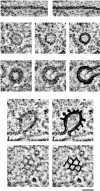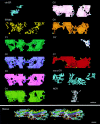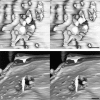Golgi structure in three dimensions: functional insights from the normal rat kidney cell
- PMID: 10087259
- PMCID: PMC2150572
- DOI: 10.1083/jcb.144.6.1135
Golgi structure in three dimensions: functional insights from the normal rat kidney cell
Abstract
Three-dimensional reconstructions of portions of the Golgi complex from cryofixed, freeze-substituted normal rat kidney cells have been made by dual-axis, high-voltage EM tomography at approximately 7-nm resolution. The reconstruction shown here ( approximately 1 x 1 x 4 microm3) contains two stacks of seven cisternae separated by a noncompact region across which bridges connect some cisternae at equivalent levels, but none at nonequivalent levels. The rest of the noncompact region is filled with both vesicles and polymorphic membranous elements. All cisternae are fenestrated and display coated buds. They all have about the same surface area, but they differ in volume by as much as 50%. The trans-most cisterna produces exclusively clathrin-coated buds, whereas the others display only nonclathrin coated buds. This finding challenges traditional views of where sorting occurs within the Golgi complex. Tubules with budding profiles extend from the margins of both cis and trans cisternae. They pass beyond neighboring cisternae, suggesting that these tubules contribute to traffic to and/or from the Golgi. Vesicle-filled "wells" open to both the cis and lateral sides of the stacks. The stacks of cisternae are positioned between two types of ER, cis and trans. The cis ER lies adjacent to the ER-Golgi intermediate compartment, which consists of discrete polymorphic membranous elements layered in front of the cis-most Golgi cisterna. The extensive trans ER forms close contacts with the two trans-most cisternae; this apposition may permit direct transfer of lipids between ER and Golgi membranes. Within 0.2 microm of the cisternae studied, there are 394 vesicles (8 clathrin coated, 190 nonclathrin coated, and 196 noncoated), indicating considerable vesicular traffic in this Golgi region. Our data place structural constraints on models of trafficking to, through, and from the Golgi complex.
Figures









References
-
- Becker B, Böllinger B, Melkonian M. Anterograde transport of algal scales through the Golgi complex is not mediated by vesicles. Trend Cell Biol. 1995;5:305–307. - PubMed
-
- Bonfanti L, Mironov AA, Jr, Martínez-Menárguez JA, Martella O, Fusella A, Baldessarre M, Buccione R, Geuze HJ, Mironov AA, Luini A. Procollogen traverses the Golgi stack without leaving the lumen of cisternae: evidence for cisternal maturation. Cell. 1998;95:993–1003. - PubMed
-
- Berger, E.G. 1997. The Golgi apparatus: from discovery to contemporary studies. In The Golgi Apparatus. E.G. Berger and J. Roth, editors. Birkhäuser Verlag, Basel, Switzerland. 1–35.
Publication types
MeSH terms
Grants and funding
LinkOut - more resources
Full Text Sources
Other Literature Sources

